The 6th gameweek of the 2021-22 Premier League season featured a mouth-watering clash between defending champions Manchester City and reigning European champions Chelsea at Stamford Bridge. Both of them have been regarded as the title contenders with Chelsea having supremely transformed under the tutelage of Thomas Tuchel.
Pep Guardiola was looking to exact a victory over Tuchel’s side having already lost three times to them last season – which also included the Champions League final.
This tactical analysis discusses the tactics used by both teams and how Pep finally managed to get one over against Tuchel to take home three valuable points. Let’s begin the analysis.
Lineups
Chelsea made three changes to the lineup that beat Tottenham last weekend with a change in formation to a 3-5-2 shape that saw the likes of Mount and Havertz make way for N’Golo Kante and Timo Werner. Reece James replaced Thiago Silva as the 3rd change.

Manchester City, on the other hand, made four changes to the lineup that was held to a stalemate by Southampton. Aymeric Laporte, Rodri, Kevin De Bruyne and Phil Foden replaced the likes of Nathan Ake, Fernandinho, Gundogan and Raheem Sterling as Pep decided to ring in changes ahead of an important UCL clash against PSG later in the week.
Chelsea struggles against Man City’s rotations
Guardiola decided to go into another game with Jesus away from the CF position and like in the previous games, he was given another chance as a right-wing forward ahead of Riyad Mahrez. Phil Foden was placed as the striker in the setup with the youngster acting as a false-nine in some situations.
The key thing behind Guardiola’s tactics on the day were to expose Chelsea and confuse them by having constant rotations among the players. The set structure was a 2-3-5 formation that has been a constant from a Pep side for a long time. It would also change to a 3-2-5 when one of the FBs would drop into the defence if needed. Mostly it would be the full-backs inverting with Cancelo almost always in the second line beside Rodri while on the right side it becomes different with the presence of Bernado Silva and Kyle Walker. Both of them are very capable and versatile with their abilities and they constantly rotated to maintain the structure while also making it difficult for the right-flank Chelsea players.
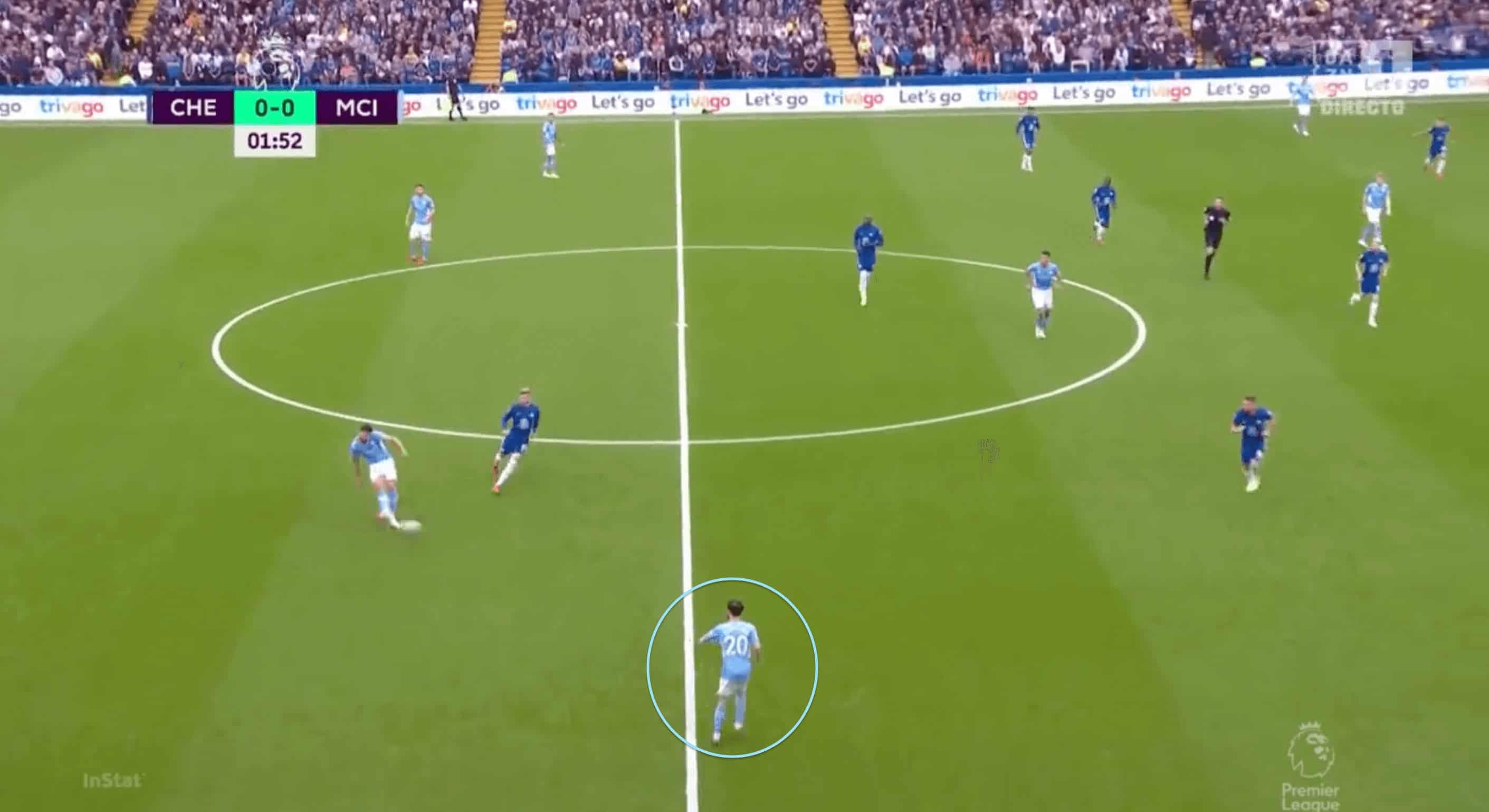
Bernardo Silva would often drop into the inverted position as one among the three players in the mid-line. This means that Walker would be wide providing the width while Jesus would stay in the half-space inverted. We can see an instance of that in the above image as Silva has dropped deep. This is where Kovacic sees an opportunity to press the Portuguese. For Kovacic, it was his role to press the player dropping into that zone, he found it difficult especially with different players. Both Walker and Silva being opposite footed, their body angles were difficult in receiving the pass. This meant that Kovacic had to be extremely careful with the way he pressed and a small misconception would lead to an easy bypass.
We can see an example of Kovacic pressing Walker. This time Walker being inverted now has the opportunity to play a central pass to Jesus forward. The presence of Bernado outside also gives them an advantage of a triangle and City would often outnumber the Chelsea player with a 3v2 advantage.
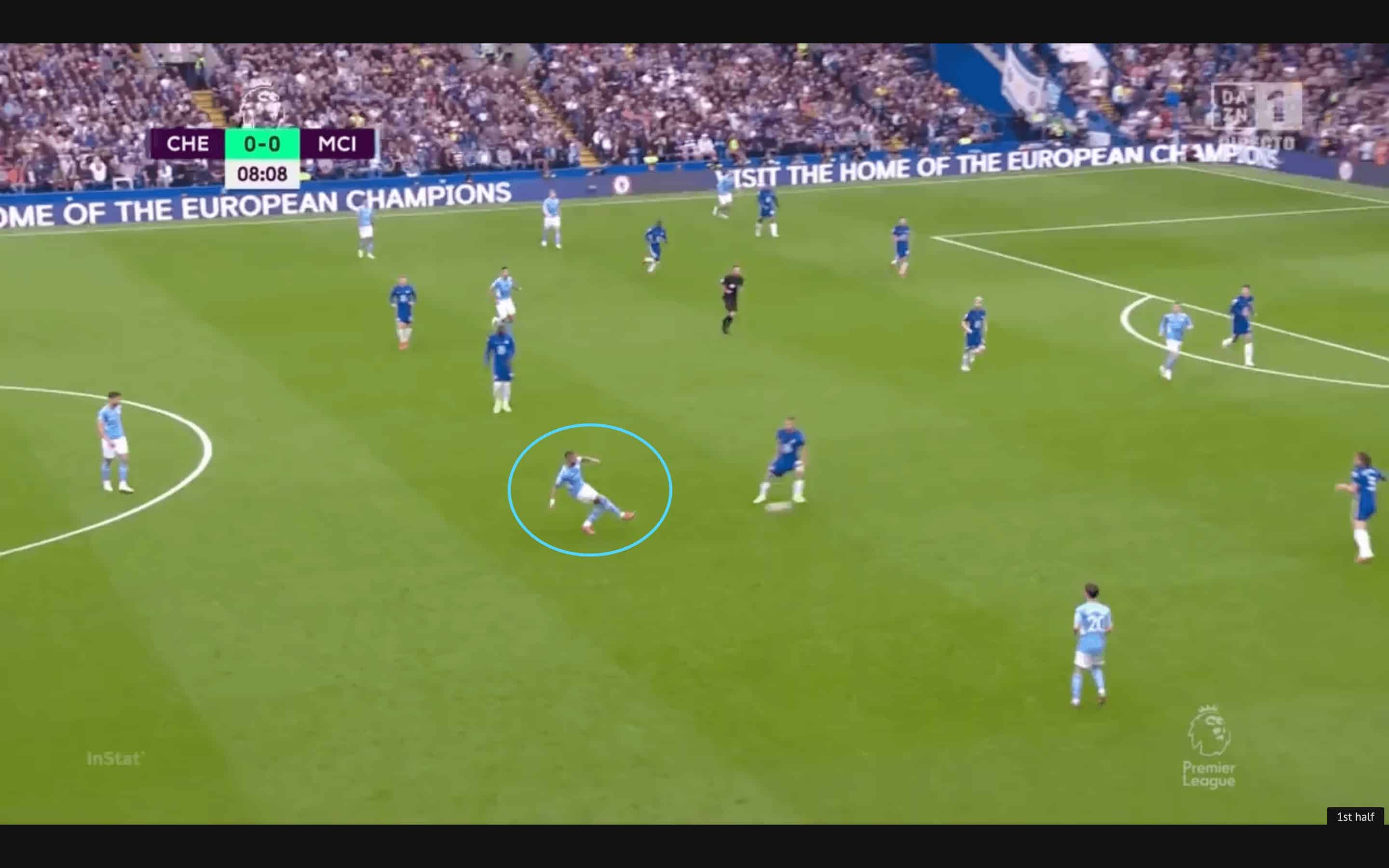
Jesus providing width would often attract Alonso to the flank and the Brazilian would often use his trickery to get past the Spaniard and enter the box. Both Bernado and Walker were shrewd enough to know when to make an underlap when Jesus stays wide. Though Rudiger fairly did well to stop these runs, City’s constant threat did unsettle the Chelsea defence as a whole.

Bernado Silva was especially important to the entire setup that Pep went with as he used his constant movements and positional versatility. His positioning and movement would often drag players from their position like how Rudiger gets dragged away from his position that opens a passing lane to Foden. Most of the City’s threat came from the right side as we can see in the image below.

Guardiola’s emphasis on occupying the right zones and not making a player redundant was on display as the players were constantly aware of each other’s positioning and occupied the right zones to ensure no two players were on the same horizontal and vertical zone. We can see KDB making a run into the left space when he sees that there is a space there while Jesus has occupied Rudiger on the ball-sided half-space.
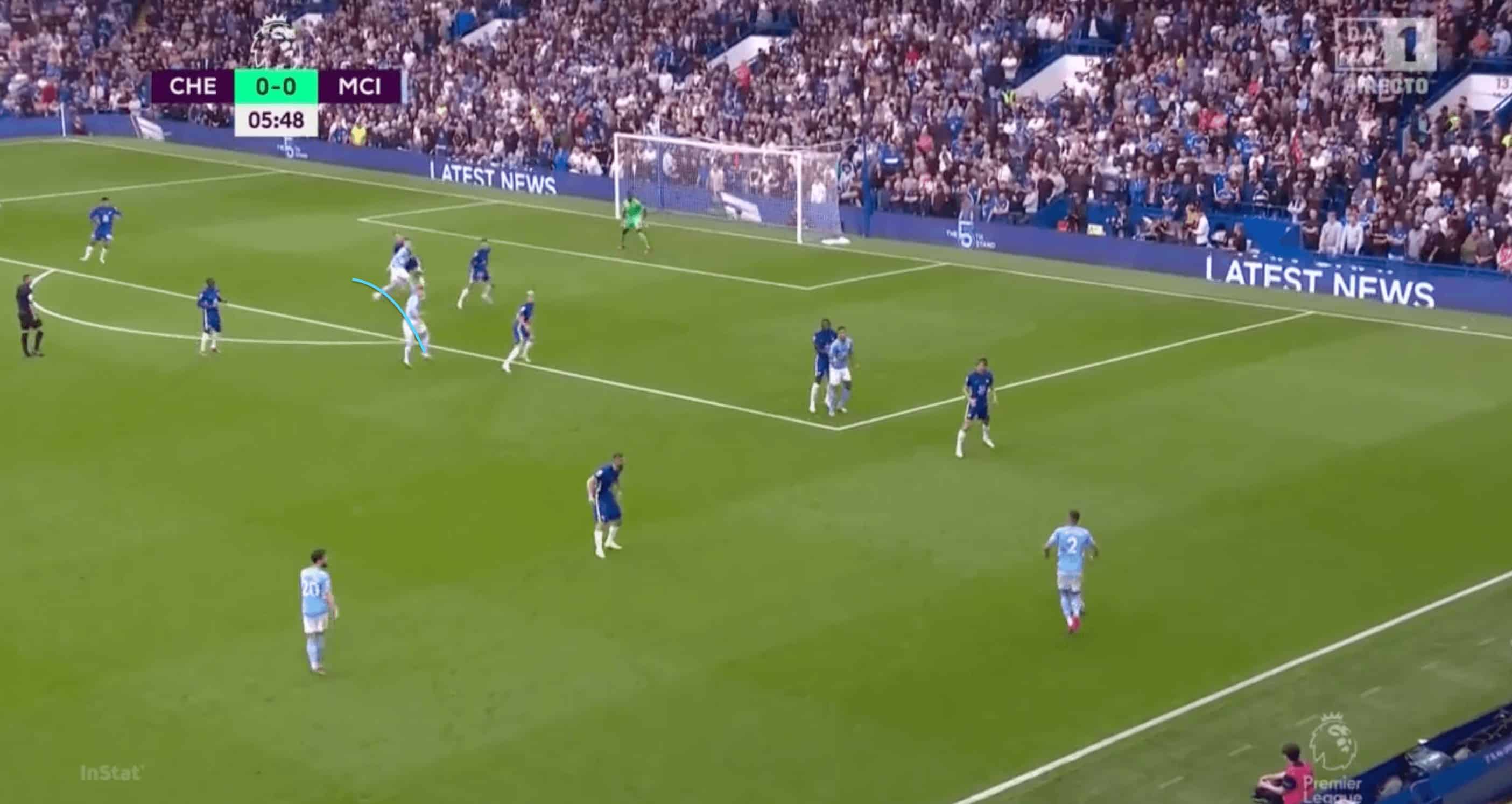
Contrasting pressing approaches by both teams
The expectations from the football fans around the world were that Tuchel would set up in a more counter-attacking way when compared to City. While City pressed very high and looked to force high turnovers, Chelsea were set up in a very passive defensive structure where they showed less intensity to press in the final third. This could be seen from the stats where Pep’s side were able to force 10 turnovers in the final third while Chelsea wasn’t able to do the same.
Manchester City decided to go with a man-man press and used the wings to good effect to win the ball back from Chelsea. We can see an example of the man-man press from them where they have maintained good distance with respect to all the players and also look to stop them playing out immediately. Before the ball is played to the wider player, the Mancity players position themselves in close proximities with players around them and especially close to the ones that are a little higher. This is to give time for the likes of Walker or Cancelo to come up and press while the forward players will go even higher to take their respective marker.

After the ball goes wider to a wing-back we can see how the City go with a man-man press with Walker going all the way up to press Alonso and the other players take positions in such a way that every one of them is covered.
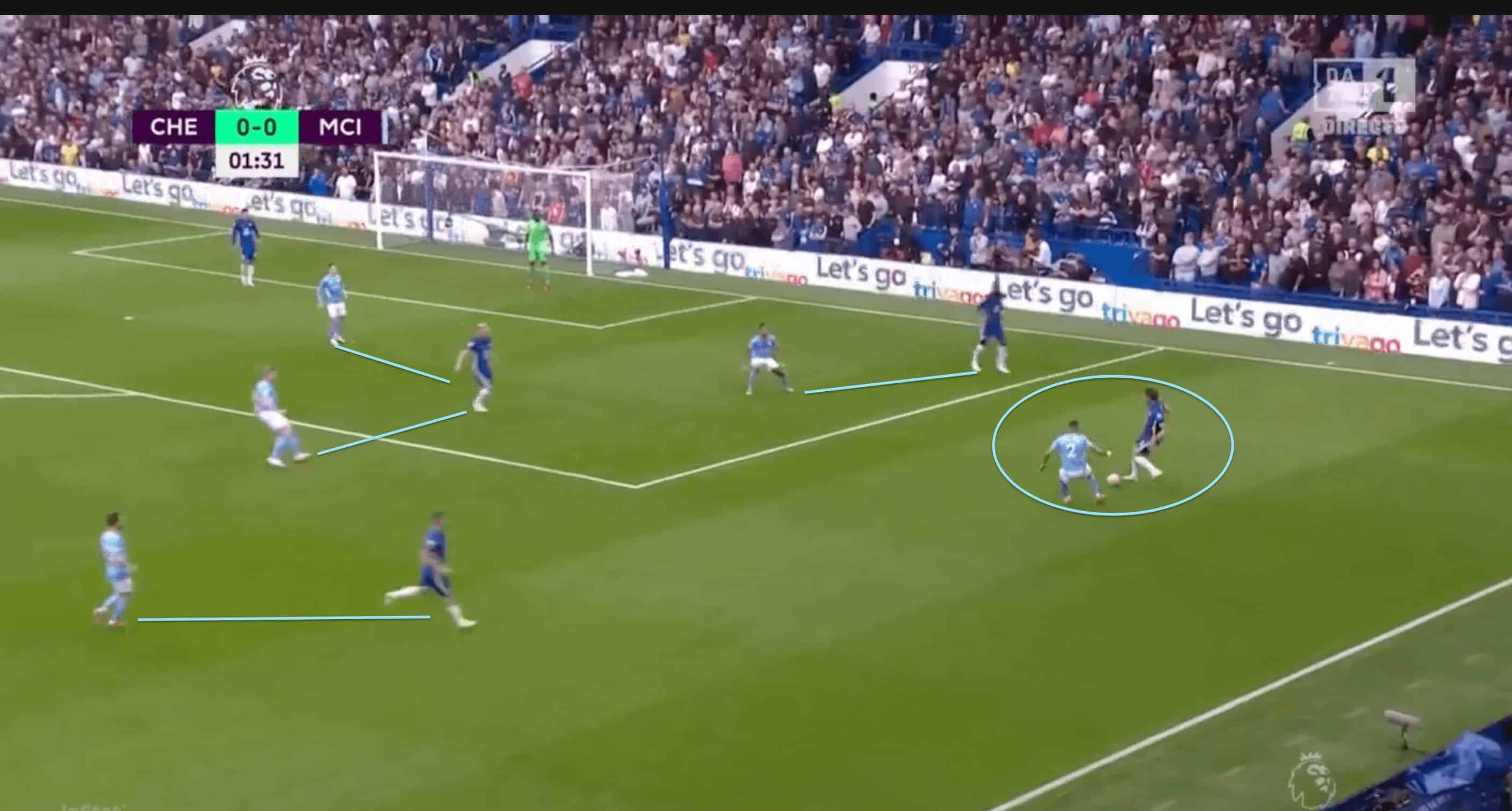
This was a risky approach from City given the fact that it would expose the likes of Dias and Laporte against Werner and Lukaku in 1v1 situations. The risk-reward was worth in most of the scenario as Chelsea weren’t able to take the ball beyond their own half.
The two CDMs would be marked by the CMs from Manchester City, KDB and Silva closely higher up the pitch. Though Chelsea did find a way out of it in the second half by dragging these players very wide and exploiting space in the centre by constant rotations. We can see Kovacic moving out wide while Silva follows him. This means that the central space has opened for the likes of Alonso to make an inverted run.

Another important thing for Chelsea was to find Jorginho free to progress the ball immediately to the likes of Lukaku or Werner or switch flanks. He would often be marked by KDB in a more central press or higher up the pitch. But when the ball is in the middle third especially in the wings, Chelsea would often have the chance to access Jorginho as Foden would be too high and Kante would be engaging KDB. The example below shows how Jorginho can be accessed by James from the flanks.

Chelsea, on the other hand, were less intense with their press. They were set in a 3-5-2 that prioritised to block central passing options and to ensure that City don’t access the players in the central regions.
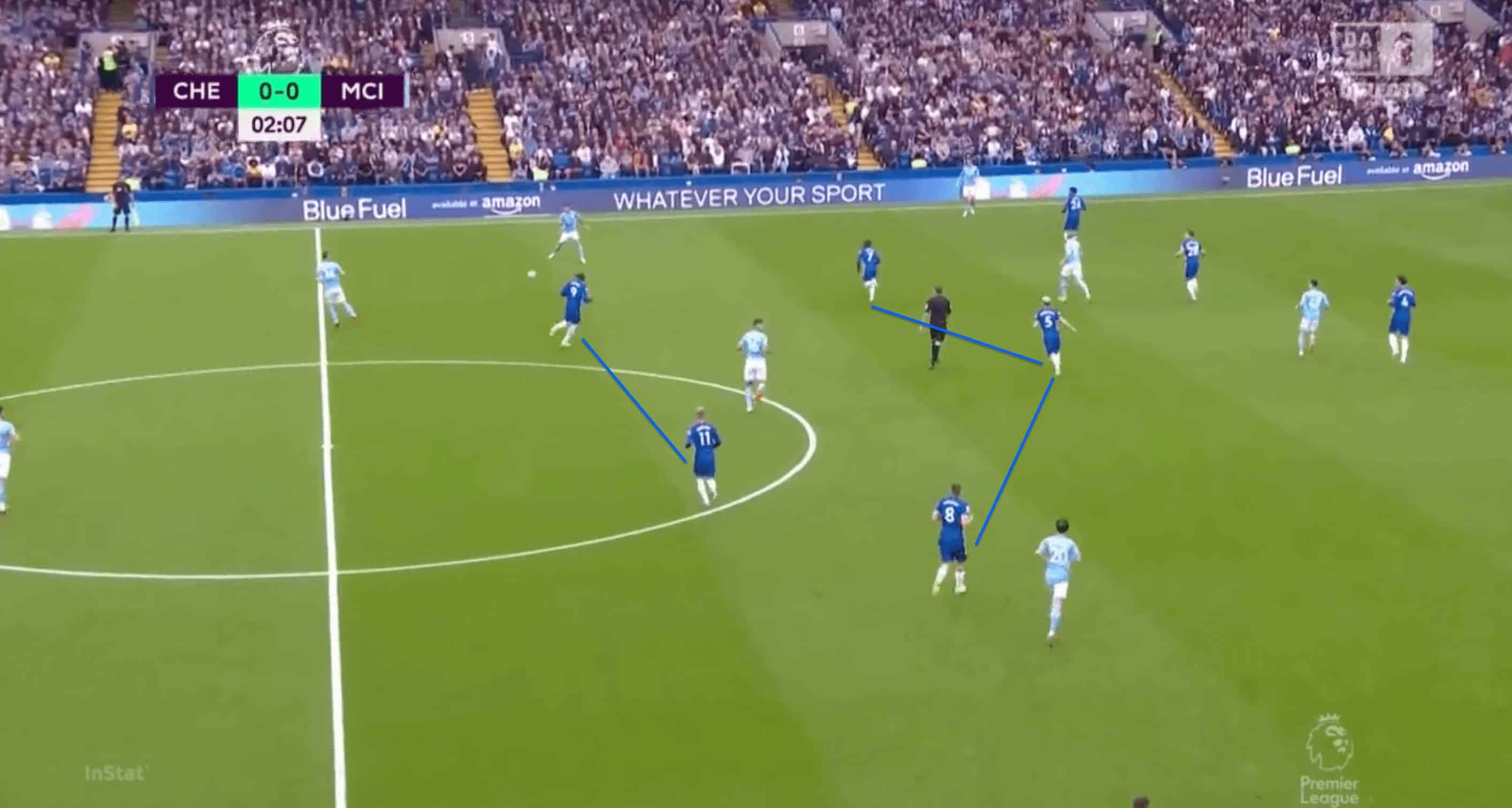
The lack of press provided City with another advantage. With Lukaku and Werner covering the passing lanes to Rodri, Kovacic on side and Kante on the other would press the inverted full-back. While the wing-backs would mark the wide players, Grealish and Jesus. But since the CBs were given free-pass, they were able to step forward with the ball. This would attract Kante or Kovacic to them and would leave the full-back out wide free to receive. We can see in the image below as Cancelo is free and if moves forward then it would be 2v1 with him and Grealish against Reece James.

City keep Werner and Lukaku fairly quiet
The biggest concern for City entering into the game was to handle the threat of Werner and Lukaku. With Werner doing well in the games against them last season and Lukaku being in super-hot form, the likes of Dias and Laporte had a lot on the plate. Chelsea would often look to use Lukaku as a target man dropping deep and holding up the ball or laying it off for another runner. Werner would be the runner on one side while Kante would often make runs on the other side.
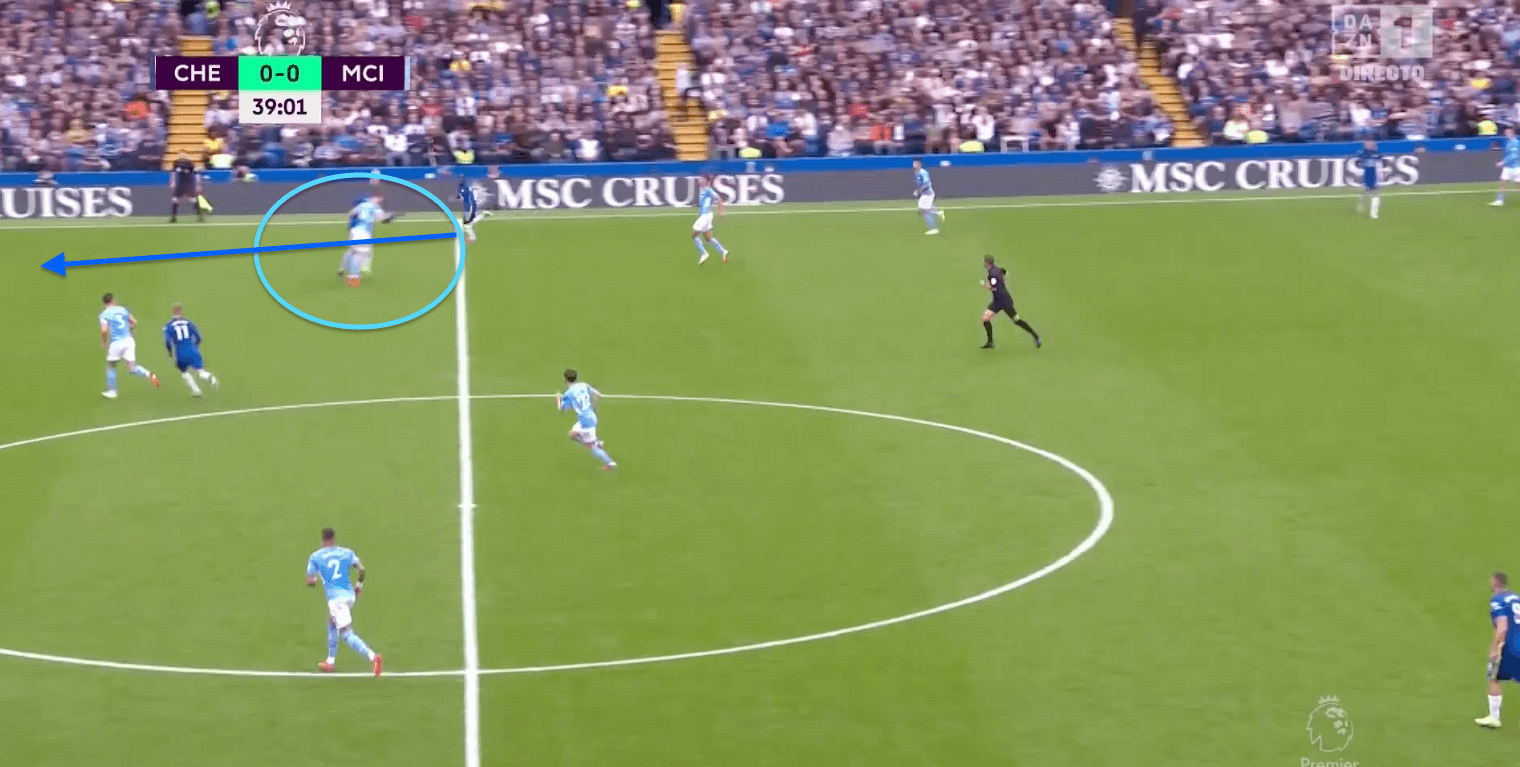
Manchester City relatively handled the duo well by not giving them too much time on the ball or counter-pressing immediately to cut the supply to them. This was aided by the narrowly positioned full-backs that helped them to counter-press effectively.

Chelsea later decided to bring in Havertz to stretch the defensive line of Man City as a two-men line was nullified mostly by the CBs. With Havertz’s mobility, he was able to drift to the wings and Chelsea’s rotational play improved with the presence of another player to form a triangle like in the image above where Alonso has inverted to occupy the half-space.

The drawback to this was with now only 2 CDMs present, City were able to take advantage of the lack of lateral cover from the midfield where a switch to the opposite flank’s half-space would give them access to player likes Grealish or Silva driving with the ball like in the above image and the wide CB now has to step up leaving space in behind for the other players to run into during counter-attacks.
Conclusion
Though it didn’t live up to the expectations after their previous encounters in the previous season, the game did give some impressive tactical battles and also gave hindsight as to how strong the title race for this season is going to be with Liverpool also in the mix. Both teams face European giants in the midweek with Manchester City travelling to Paris to take on PSG while Chelsea travel to Turin to take on Juventus.





Comments